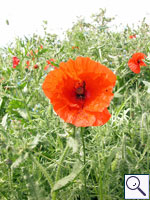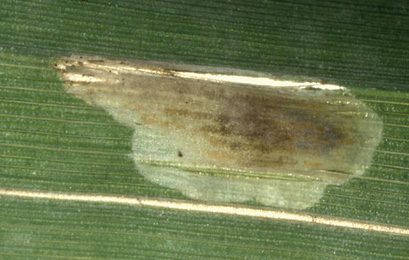|
||||||
|
PAPAVER. Poppy. [Papaveraceae] |
|
|
Fifteen species of Papaver are recorded in Britain. These include the native Prickly Poppy (P. argemone), Long-headed Poppy (P. dubium dubium), Yellow juiced Poppy (P. dubium lecoqii), Rough Poppy (P. hybridum) and Common Poppy (P. rhoeas). The BSBI provide a downloadable plant crib for Papaver and a video on YouTube. Four British miners are recorded on Papaver in Britain. A key to the European miners recorded on Papaver is provided in Bladmineerders van Europa. |
 Common Poppy Papaver rhoeas |
Key for the identification of the known mines of British |
|||
1a > Leaf-miner: Mine linear, whitish, both upper and lower surface. Pupation internal, at the end of the mine with the anterior spiracles projecting through the epidermis (Spencer, 1976: 433). Upper-surface, less often lower-surface corridor. Frass in isolated grains. Pupation within the mine, usually in a lower-surface puparial chamber. A long whitish upper surface corridor, which eventually goes lower surface. |
|||
|
|||
Chromatomyia horticola (Goureau, 1851) [Diptera: Agromyzidae]. |
|||
1b > Leaf-miner: A distinctive mine primarily above mid-rib, with irregular short lateral offshoots into leaf blade. Pupation external (Spencer, 1972: 51 (fig. 172), 55; Spencer, 1976: 270, 271 (fig. 486)). Branched, whitish, upper-surface corridor; main axis overlying the midrib; side branches overlying the main lateral veins. (In Campanula and Phyteuma the mine is much less branched, sometimes nothing more than a corridor on top of the midrib). Frass in rather long strings. Usually the mines begins as a long and narrow, shallow, tortuous lower-surface corridor that ends upon the midrib but otherwise is not associated with the leaf venation. Often this initial corridor is filled with callus, and then even less conspicuous. Pupation outside the mine. A linear mine on the upper surface, usually following the midrib and showing side branches along the veins. The frass is in strings. |
|||
|
|||
|
|||
Liriomyza strigata (Meigen, 1830) [Diptera: Agromyzidae]. |
|||
1c > Leaf-miner: Corridor-blotch mine, normally dorsal; usually whitish; in small leaves it lies characteristically in the centre of the leaf often touching the petiole; in larger leaves it lies to one side of the mid-rib. Frass deposited in green clumps near the leaf margin. Pupation usually external, sometimes in a separate pupation mine. Oviposition whitin the leaf, at the lower surface. The first part of the mine is a long, sometimes very long, corridor, that mostly will be overrun by the later developments. Generally this corridor is directed, frequently guided by a thick vein, to the midrib. The next section of the mine is large, irregular blotch overlying the basal section of the midrib. Locally large chunks of midrib tissue are consumed. From this central blotch excursions are made into the leaf blade: generally upper-surface, less often lower-surface and locally full-depth. In plants with narrow leaves, like Diplotaxis, the mine may occupy the entire width of the leaf. Often several larvae together in a mine. Frass blackish green, powdery, in clouds, sometimes along the sides of the corridors, later more in the periphery of the mine and in the end of extensions of the blotch, sometimes seemingly absent. (Often the frass can only be seen after the mine has been opened). Pupation generally in the ground, rarely within he leaf, in a short mine without frass. Hendel (1928a) described the biology, larva and puparium. An initial narrow gallery then leads to a blotch on the midrib of the leaf. Watch a video of a scaptomyzid fly larva on Arabidopsis on YouTube by mash92587. |
|||
|
|||
Scaptomyza flava (Fallén, 1823) [Diptera: Drosophilidae]. |
|||
1d > Leaf-miner: Irregular mine, locally shallow, elsewhere much deeper, giving it a mottled appearance. In broadleaved plants the mine often begins as a blotch with stellate extensions, but sometimes as a very fine, shallow corridor. In grasses the mine often begins in the leaf sheath. The frass is very fine-grained, initially scattered, later in aggregates. The egg is deposited on the plant surface, and the empty egg shell remains visible. But the larvae are able to leave their mine and restart elsewhere, thus mines without an egg shell can be found as well. The larva also leaves the mine before pupation. Pupation takes place in a newly made, small, blotch mine without frass; this mine may be made in another plant (species). |
|||
 Mine of Hydrellia griseola on Glyceria fluitans Image: © Willem Ellis (Bladmineerders van Europa) |
|||
|
|||
Hydrellia griseola (Fallén, 1813) [Diptera: Ephydridae]. |
| Last updated 09-Jul-2020 Brian Pitkin | ||

